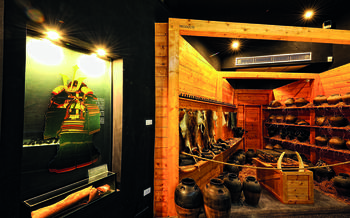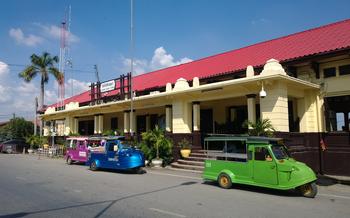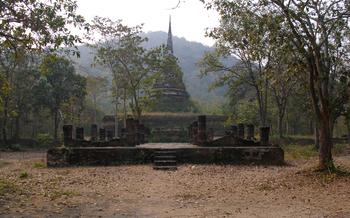
Ban Na Pong Wai Archaeological Site
- The Antiquity of Phrae
- Discovery of Ban Na Pong Wai
- Historical Importance
- Preserved Artifacts
- Religious Significance
- Moated City Structure
- The Nan River's Role in Ban Na Pong Wai's Development
- City Planning and Architecture
- Community Involvement: A Cornerstone of Archaeological Discovery
- Museum Exhibits
- Excavation Challenges
- Future Research and Conservation
- Historical Context
- Educational Opportunities
- Insider Tip: Making the Most of Your Visit
The Antiquity of Phrae
Phrae, a province in northern Thailand, boasts a rich and ancient history that dates back centuries. As part of the ancient Kingdom of Hariphunchai, which flourished from the 7th to the 13th century, Phrae played a significant role in the political and cultural landscape of the region. Archaeological discoveries in the province, including the Ban Na Pong Wai archaeological site, have shed light on the region's intriguing past and its connection to the wider history of Thailand. These discoveries provide valuable insights into the lives and customs of the ancient inhabitants, offering a glimpse into a bygone era.
Discovery of Ban Na Pong Wai
The excavation of the ancient city of Ban Na Pong Wai began in the early 20th century, led by a team of Thai and international archaeologists. The excavations revealed a wealth of artifacts, including pottery, tools, ornaments, and Buddhist stupas and sculptures. These findings provided valuable insights into the daily life, religious beliefs, and cultural practices of the ancient inhabitants of Ban Na Pong Wai.
The collaboration between Thai and international archaeologists in the excavation of Ban Na Pong Wai is a testament to the importance of international cooperation in archaeological research. This collaboration has allowed for the sharing of knowledge and expertise, leading to a better understanding of the history and culture of Ban Na Pong Wai and the Hariphunchai Kingdom.
Historical Importance
Ban Na Pong Wai played a crucial role in the Hariphunchai Kingdom as a significant urban center and a gateway to trade and cultural exchange. Its strategic location along the Nan River facilitated the movement of goods and ideas between the kingdom and neighboring regions. The city served as a hub for trade, with merchants from various parts of Southeast Asia converging to exchange goods and foster economic ties.
Moreover, Ban Na Pong Wai's role as a gateway extended beyond trade, as it also served as a conduit for cultural exchange and the spread of religious practices. The city's proximity to other major cultural centers, such as the Mon Kingdom of Hariphunchai and the Khmer Empire, facilitated the transmission of cultural influences, including artistic styles, religious beliefs, and social customs. This vibrant exchange contributed to the development of a rich and diverse cultural tapestry in the region.
The archaeological findings at Ban Na Pong Wai provide tangible evidence of a thriving ancient civilization. The presence of well-planned city structures, sophisticated irrigation systems, and a variety of artifacts, including pottery, tools, and ornaments, attests to the city's prosperity and the high level of craftsmanship achieved by its inhabitants. These discoveries shed light on the daily lives of the ancient people, their economic activities, and their social organization, offering valuable insights into the development of early urban centers in Thailand.
Preserved Artifacts
The excavation of Ban Na Pong Wai has unearthed a treasure trove of artifacts that provide invaluable insights into the daily life and culture of its ancient inhabitants. Among the most significant findings are pottery shards, tools made of stone and metal, and exquisite ornaments crafted from precious metals and gemstones. These artifacts showcase the remarkable craftsmanship and artistry of the people who lived in this ancient city.
The pottery fragments, in particular, offer a glimpse into the culinary practices and household activities of Ban Na Pong Wai's residents. The variety of shapes and sizes suggests that pottery served various purposes, from cooking and storage to serving food. The intricate designs and patterns adorning some of the pottery shards hint at the aesthetic sensibilities of the ancient potters.
The tools discovered at the site provide evidence of the diverse occupations and industries that existed in Ban Na Pong Wai. Stone tools, such as axes, grinding stones, and chisels, indicate that the inhabitants engaged in agriculture and construction. Metal tools, including bronze knives and arrowheads, suggest that metalworking was a significant craft in the city.
Perhaps the most captivating artifacts are the ornaments, which include necklaces, bracelets, earrings, and rings. These pieces are adorned with precious stones such as rubies, sapphires, and emeralds, showcasing the wealth and status of the city's elite. The intricate designs and motifs incorporated into the ornaments provide valuable clues about the cultural and religious beliefs of the ancient inhabitants.
The preservation of these artifacts is of paramount importance, as they serve as tangible links to the past and provide a window into the lives of the people who once called Ban Na Pong Wai home. Through careful conservation and documentation, these artifacts will continue to contribute to our understanding of this ancient civilization and its place in the broader history of Thailand.
Religious Significance
Ban Na Pong Wai holds immense religious significance as a testament to the influence of Theravada Buddhism in the region. Excavations at the site have unearthed several Buddhist stupas and sculptures, providing valuable insights into the religious practices and beliefs of the ancient inhabitants. These discoveries have contributed significantly to the history of Buddhism in Thailand, shedding light on the spread and development of this major religion in Southeast Asia. The presence of stupas and sculptures suggests that Ban Na Pong Wai may have been an important religious center within the Hariphunchai Kingdom, serving as a place of worship and pilgrimage for the local population. Furthermore, these findings highlight the interconnectedness of religious and cultural traditions in the ancient world, emphasizing the importance of understanding the role of religion in shaping the development of societies and civilizations.
Moated City Structure
Ban Na Pong Wai's city walls stand as unique testaments to the ingenuity and strategic planning of its ancient inhabitants. Constructed in a pentagon shape, these walls provided a formidable defense against potential attacks. The city's moat, which once flowed with water, further enhanced its defensive capabilities, creating a natural barrier that deterred intruders. The city's positioning on a hilltop further added to its strategic advantage, providing a commanding view of the surrounding landscape.
Intriguingly, Ban Na Pong Wai's city walls feature an unusual design element: a protruding section on the western side. This unique feature may have served as a reinforced defense point, providing additional protection against attacks from that direction. The city walls' thickness and height also indicate their defensive purpose, as they were constructed to withstand potential sieges and attacks.
In comparison to other ancient cities in Thailand, Ban Na Pong Wai's city walls exhibit distinct characteristics. While many ancient cities in the region were surrounded by simple earthen ramparts, Ban Na Pong Wai's walls are constructed using a combination of earth and brick, demonstrating a more advanced level of construction techniques. This unique blend of materials not only enhanced the city's defenses but also provided a more permanent and durable structure.
The Nan River's Role in Ban Na Pong Wai's Development
The Nan River played a pivotal role in the development and prosperity of Ban Na Pong Wai. This mighty waterway served as a crucial transportation route, connecting the ancient city to other settlements and facilitating trade and cultural exchange. The river's strategic location allowed for the easy transport of goods and ideas, contributing to the city's economic growth and cultural vibrancy.
The Nan River was a bustling hub of activity, with boats laden with various commodities, including agricultural products, textiles, and precious metals, plying its waters. This riverine trade brought wealth and prosperity to Ban Na Pong Wai, transforming it into a flourishing center of commerce. Additionally, the river facilitated cultural exchange, as people from different regions and cultures traveled along its course, sharing ideas, customs, and beliefs, which enriched the cultural tapestry of the city.
The Nan River's influence extended beyond trade and cultural exchange. It also played a role in the city's defense. The river served as a natural barrier, providing protection from potential invaders. The city's strategic location on the river allowed its inhabitants to monitor and control the movement of people and goods, ensuring the city's security.
Overall, the Nan River was a vital lifeline for Ban Na Pong Wai, contributing to its economic prosperity, cultural vibrancy, and strategic importance. Without the river's presence, the city would not have flourished to the extent it did, showcasing the profound impact of waterways on the development of ancient civilizations.
City Planning and Architecture
The ancient city of Ban Na Pong Wai exhibits a well-thought-out city plan and impressive architectural feats. The city's layout showcases a clear organization, with residential areas, administrative buildings, and religious structures strategically placed within the city walls. The residential areas comprise clusters of houses, each featuring a courtyard and surrounded by earthen walls for privacy. The administrative buildings, possibly used for governance and public gatherings, display intricate designs and larger dimensions compared to the residential dwellings.
The architectural styles and influences found at Ban Na Pong Wai reflect the diverse cultural influences that shaped the city. The presence of both indigenous and foreign architectural elements suggests the city's role as a melting pot of cultures. The stupas and religious structures, for example, showcase influences from Theravada Buddhism, while the city walls and fortifications exhibit defensive features commonly found in ancient Southeast Asian cities.
A comparison of Ban Na Pong Wai with contemporary cities in the region reveals similarities and differences in city planning and architecture. While some cities, such as Sukhothai and Ayutthaya, share similar characteristics in terms of their moat systems and city layouts, Ban Na Pong Wai's unique features, such as its smaller size and the presence of residential clusters, set it apart from its contemporaries. These distinctions highlight the city's individuality and the diverse nature of urban development in ancient Thailand.
Community Involvement: A Cornerstone of Archaeological Discovery
The excavation and exploration of Ban Na Pong Wai would not have been possible without the collaboration and involvement of the local communities. Archaeologists recognize the importance of engaging with local residents, seeking their knowledge, and respecting their cultural heritage. This collaboration has fostered a sense of ownership and pride among the community members, who actively participate in the research and preservation efforts.
Community involvement extends beyond providing historical insights. Locals often assist with excavations, offering their expertise in the terrain and local customs. They also contribute to the interpretation of findings, shedding light on the daily lives and traditions of their ancestors. This collaboration has created a mutually beneficial relationship between archaeologists and the community, ensuring the preservation of the site while fostering a deep appreciation for its historical significance.
To further strengthen this partnership, cultural events and festivals are organized, showcasing the rich history and traditions of Ban Na Pong Wai. These events celebrate the community's heritage, promote local artisans and crafts, and provide a platform for cultural exchange. Through these initiatives, the community becomes an active participant in the preservation and promotion of their ancestral legacy.
Museum Exhibits
The artifacts unearthed at Ban Na Pong Wai are proudly exhibited in local museums such as the Phrae National Museum, providing an up-close look into the city's rich past. These museums house a diverse collection of pottery, tools, ornaments, and other relics, offering visitors a glimpse into the daily lives and traditions of the ancient inhabitants. Interactive exhibits and multimedia displays enhance the museum experience, making it an informative and engaging journey through time.
Preserving and showcasing these artifacts is of utmost importance, as they serve as tangible evidence of the city's existence and the vibrant civilization that once thrived. Museums play a pivotal role in educating the public about the significance of Ban Na Pong Wai's archaeological heritage, fostering appreciation for the city's contribution to Thailand's cultural tapestry.
Excavation Challenges
Unveiling the secrets of Ban Na Pong Wai presented a multitude of challenges for archaeologists. The site's delicate nature and exposure to the elements demanded meticulous care and expertise during excavations. Environmental factors, such as tropical weather conditions and fluctuating humidity levels, posed significant risks to the preservation of artifacts and the overall integrity of the site.
Archaeologists had to strike a delicate balance between the pursuit of knowledge and the conservation of the site's heritage. Minimizing disturbance to the surrounding environment and employing non-invasive techniques were crucial to preserving the authenticity and integrity of the archaeological record. The use of advanced technology, such as ground-penetrating radar and LiDAR scanning, allowed for detailed mapping and analysis of the site without causing any physical disruption.
The excavation process also required careful coordination and collaboration among a diverse team of experts, including archaeologists, historians, anthropologists, and conservators. Each discipline brought unique perspectives and methodologies, ensuring a comprehensive and interdisciplinary approach to the excavation and interpretation of the site.
Future Research and Conservation
The Ban Na Pong Wai archaeological site continues to yield exciting discoveries, attracting researchers from around the world. Ongoing excavations aim to uncover more secrets of this ancient city, including its urban planning, social structure, and trade networks. Future research projects will focus on analyzing the artifacts, studying the site's chronology, and reconstructing the daily lives of its inhabitants.
Conservation efforts are paramount to preserving the integrity of Ban Na Pong Wai. The site's fragile remains require careful management and protection from environmental factors, such as erosion and vegetation growth. Sustainable development practices are being implemented to ensure that tourism and research activities do not harm the site's historical significance. The local community plays a vital role in safeguarding the archaeological remains, working closely with archaeologists to monitor and maintain the site.
Historical Context
Ban Na Pong Wai's significance extends beyond its regional importance; it is an integral part of Thailand's rich historical tapestry. The city's existence during the Hariphunchai Kingdom places it within a broader narrative of ancient Thai civilization. Hariphunchai, centered in modern-day Lamphun, was a powerful kingdom that flourished from the 7th to the 13th centuries, leaving an indelible mark on the region's history and culture. Ban Na Pong Wai, as a gateway city to this kingdom, played a crucial role in trade, cultural exchange, and the dissemination of Theravada Buddhism throughout the region. Its connection to other ancient settlements and kingdoms, such as the Mon Kingdom of Haripunjaya and the Khmer Empire, further highlights its importance in the development of Thai civilization. Understanding Ban Na Pong Wai's place within this broader historical context provides a deeper appreciation of its significance and the role it played in shaping the Thailand we know today.
Educational Opportunities
Ban Na Pong Wai presents an exceptional opportunity for students and researchers interested in archaeology, history, and cultural studies. Workshops, seminars, and educational programs are conducted regularly, allowing participants to delve into the intricacies of the site's past. Collaborations with educational institutions facilitate research and learning, providing students with hands-on experience in archaeological methodologies and techniques. These initiatives not only promote the significance of archaeological studies but also foster a new generation of scholars dedicated to preserving and understanding our rich cultural heritage.
Insider Tip: Making the Most of Your Visit
To fully appreciate the beauty and significance of Ban Na Pong Wai, plan your visit during the dry season, which runs from November to April. This period offers pleasant weather conditions, making it ideal for exploring the archaeological site.
For a more immersive experience, consider hiring a local guide or joining a guided tour. These knowledgeable guides can provide insights into the history and significance of the site, bringing the ancient city to life. They can also point out hidden details and lesser-known stories that you might miss on your own.
When planning your trip, remember that Ban Na Pong Wai is located in a rural area. While there are limited accommodation and dining options in the immediate vicinity, the nearby town of Phrae offers a range of hotels, guesthouses, and restaurants to suit different budgets and preferences.






